Chinese transition destroyers: The Luhu clas destroyers constituted in 1993 a significant improvement over the Luda class, a domestic design that approached the capabilities of Western detroyers, but made to achieve this goal extensive use of foreign technologies still accessible to the PRC before the 1989 incident and subsequent ban. They were also the first Chinese DDs to use gas turbine engines, and to be fitted with a a integrated combat system. Although impressive compared to previous designs, it must be compared to the contemporary Arleigh Burke and Kongo designs.
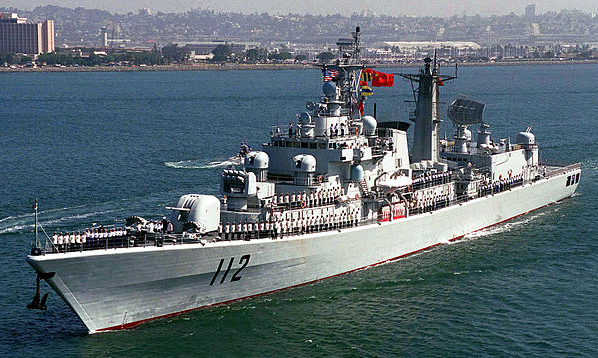
Destroyer Harbin, DDG-112
The Luhu class destroyers was the first class studied as a replacement for the old Luda class prior to the end of the cold war. There has been waves of modernizations meanwhile, up to the point of creating brand new sub-classes, thanks to the 1980s opening to the West and rapid updates to the standards of western electronics. This bring a real value to ships that were at first closely modelled on the Soviet early Kotlin class destroyers. The “Luda II and III classes” were a continuation of the famous Luda class of the 1970s, modernized in several batches. They were in service by 1992. But the fleet was ageing fast, and by the 2000s, decommissions started (By 2007, the Jian and Xi’an sticken, Changsha in 2008, and four more in 2012-2013.) as new units entered service, notably of the Luhu (Type 052) and Luhai classes (Type 51B).
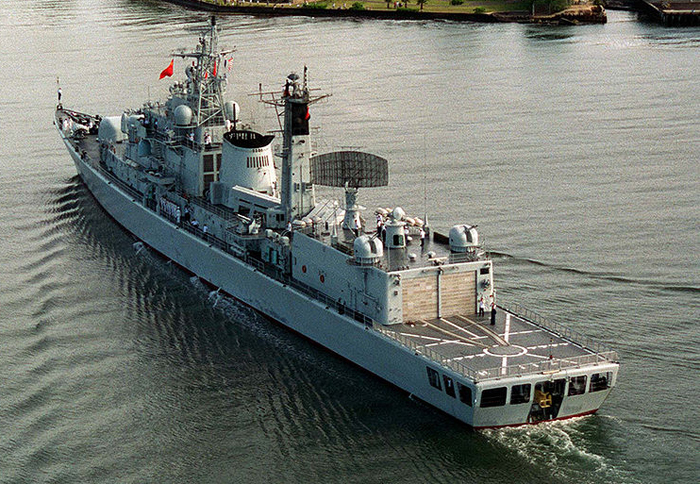
Destroyer Qindao entering Pearl Harbor in 1996. This was during an US Officers inspection that the nature of “technology demonstrator” of both ships could be established.
The Luhu class only counted two ships, imatriculated 112 and 113, the Harbin (At first called by th West Zhanjiang) and Qingdao. They were a massive improvements over the previous design, in particular in terms of tonnage (almost doubled), and were designed from the keel up to integrate the latest Western electronics and armaments. It was a quantum leap in technology, that announced the future catching up of the Chinese PLAN, more in accordance to the will to built a powerful blue water navy (Today’s PLAN budget is only second to the US Navy) capable of projections of power far away from the traditional Chinese sphere of influence and not only as a defensive naval force.
The Luhu class integrated a much larger hull, modern CODOG propulsion and diesels, modern SAMs, artillery, ASW missile system, and moreover a large hangar for two ASW helicopters. The design was more in line of what types of Destroyers the JSDNF used to put at sea and operate. They were however still lightyears from the contemporary Kongō-class destroyer, using AEGIS, just launched at that time. The Luhu appears now like a transitional design, still stuck very much on the cold war. Both were launched in 1991 and 1993 (probably laid down in 1989 and 1990 at Jiangnan yard and in service by 1994 and 1996.
Design development and overview
Basically the new class was an enlargement of the Luda class, at first planned to integrate US electronics and weaponry and even a General Motors gas turbines and propulsion system. However the 1989 embargo after the Tian-an-Men massacre ruined all these prospects and had severe consequences of supplies afterward. According to Conways 1947-1994 volume, released at that date, both ships plans had to be entirely redrawn to comprise new equipment, like possibly Russian-designed gas turbines, and “probably equipped with the Chinese-versions of the french Tavitac 2000 CDS”. In fact, as it is known today, both ships were eventually equipped as planned with General Electric LM2500 gas-turbines and German MTU diesels, while the electronics comprised indeed a Thomson-CSF TAVITAC and local systems, plus local armament, with the exception of the HQ-7 SAM, a close copy of the French Crotale short SAM system.
Both ships had been significantly upgraded in 2011 and were considered the best Chinese destroyers before the building and transfer from Russia of four Sovremenny class destroyers. They are now eclipsed by the 8500 tons Type 052B/C/D Luyang class destroyers.
Genesis
Both ships had been planned by the China Warship Design Institute (former Seventh Academy of the defence Ministry) to be built at Jiangnan Shipyard. Blueprints were elaborated under the supervision of the Chief designer was academician Mr. Pan Jingfu (潘镜芙). French-made radars and fire-control systems and General Electric gas turbine engines were concerned, being delivered already before the ban. However even with Western technology, there was still no adequate shipborne air defense systems. Surface-to-air missiles deployed indeed had a visual-range targeting system only limitiog operations to the land-based aircraft action range, condemning any blue water policy. The Luhu destroyers like the Jiangwei class frigates were both conceived to end this state of affairs by adopting the modern HQ-7 SAM quite an improvements, but still, short range and using visual range (WVR). By contrast the latest Type 052D destroyers combines the HHQ-9 long range, HQ-16 medium range and DK-10A and HHQ-10 short range SAMs to cover a very large cone around the ship.

Harbin, side view
General Characteristics
As built the ships were 4,800 tons standard (5,700 tons fully loaded according to Conway’s), for a length of 144 m (versus 132 m on the Luda), a beam of 16 m (versus 12.8m) and a draught of 5.1 m (versus 4.39m) and was propelled by a pair of General Electric LM2500 gas turbines CODOG, delivering 55,000 shp (53.600 for Conways), coupled with two MTU 12V1163 TB83 diesels, delivering 8840 bhp for 20 knots in cruise, and 5000 nautcal miles in range at 16 knots. The only let down was the top speed, that passed from 32 knots (Luda) to 30 knots (Conways). Complement range was comprised between 260 and 300 (Conways). 260 seems more reasonable given the figures of the better automated Type 052D (280). In general shape, the ships are a clear departure of the largely WW2-style segmented approach of the Luda, with alternating missile launchers instead of torpedo tubes banks.
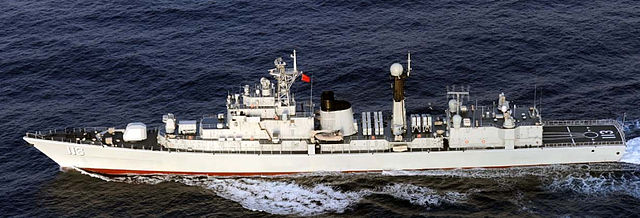
Qindao top view
Electronics
On the electronics side, both ships received re-labelled foreign equipments of various European origins, with extensive documentations still written in English, French, Italian or German. Type 756 radars1, MX-9022, Thomson-CSF Sea Tiger3, Hai Ying4, Thomson-CSF DRBC-32F5, and Type 347G6, plus a bow-mounted sonar and VDS.
1-The Type 756 is a Chinese navigational radar developed by Shanghai 4th Radio Factory, Dual band S/X first S-band in China, solid state with digit display of the range and bearing, on 96 nautical mile
3-Thomson-CSF Sea Tiger: Relabelled later Type 363 radar, with a single solid spine array. E/F – band, PRF: 2200/1100pps, Scan Rate: 15 or 24 rpm and detecton range 60 nm on 2m2 target with P(d) 50%.
4-Hai Ying radar (“Sea Eagle”): Also known as Type 382 Radar, a dedicated naval 3-D air search radar meant to replace the Type 381, and Chinese copy of Russian MR-710 Fregat (NATO Top Plate), dual bands S (E/F) and C (G/H) , 100 kW, 250 km range.
5-Thomson-CSF DRBC 32F: Standard weapon-direction system used for Crotale (HQ-7 SAM) missiles.
Critics about the lack of electronic warfare capabilities was answered in 2011’s refit of the ships, with the adoption of two Type 726-4 122mm 24-tube decoy launchers, installed on both sides of the forward bridge.
Armament
Anti-Ship: Four quadruple 4 YJ-83 (C-803) anti-ship missiles
Anti-Air: Octuple cell HQ-7 SAM (8+16 rounds)
Dual purpose AA/AM: Type H/PJ33A dual 100 mm/56 dual purpose gun, two H/PJ12 (Type 730) 7-barrel 30 mm CIWS
After 2011 upgrade: Four Type H/PJ76A dual 37 mm AA guns
ASW: two Triple Yu-7 torpedo tubes, Two Type 87 6-tube ASW rocket launchers
After 2011 Upgrade: Two Type 75 12-tube ASW rocket launchers.
C-803 (NATO CSS-N-8 Saccade): A 715 kg, 6.392 m by 36 cm anti-ship missile. Derived from the Chinese YJ-8 (C-801) with extended range of 350 km. They are fitted in pairs of oblique-mounted launchers behind the funnel, and fore and aft of the rear antenna mast. Developed by the China Haiying Electromechanical Technology Academy it is closely based on the Exocet missile both in general shape, operatory mod and capabilities. It is small enough to be airborne as well. This turbojet missile operates at 3–5 m altitude when attacking and 5–7 m when cruising at Mach 0.9, uses Inertial and terminal active radar and carries a 285 kg time-delayed semi-armour-piercing high-explosive payload.
HQ-7 SAM: Also used by the PLAGF (Land Forces), the HQ-7 (hóng qí or “red flag”/”red banner”) is a short-range air defense missile closely based on the French Crotale defence system developed by Thomson-CSF in 1978-1979 and imported for “evaluation”. Both the missile and launcher, and the Sea Tiger radars were comprehensively reverse-engineered. Production started in 1988. The HQ-7 is 85 kgs and can reach an operational altitude of 30–5,000 m (98–16,404 ft), carrying at Mach 2.3 an HE-Frag warhead while the radar detecting range was 18.4 km (HQ-7/FM-80). It was replaced by the HQ-16.
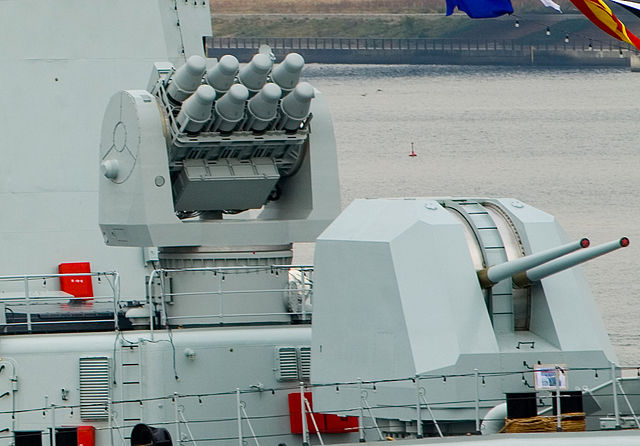
HQ-7 and Type 79A, 100mm gun turret
H/PJ33A dual 100 mm/56: First indigenously developed large caliber Chinese naval gun to replaced the Soviet-built Bu-34. Twin barrel, with a redesigned gun turret with stealthy features replacing the Type 79A but quickly replaced on other ships by the faster Type 210 and HPJ87. The Type 79A was using a French-designed autoloader. https://www.navweaps.com/Weapons/WNPRC_39-56_ENG2.php
NATO reception and experts opinion
When the ship was operational, and although it was a clear departure over previous designs with many modern features, its operational capability were called into question by analysts. As a good will gesture when making a stop, US Naval officers were allowed on board, inspecting the No. 112 Harbin in 1997 (two years after the ship went into service) taking many photos in the process. It appeared from these that the ships were mainly intended as technology demonstration vessels rather than fully operational, combat-ready destroyers. Indeed with many foreing equipments from turbines to diesels, electronics, and equipments still still labeled in the language of the country of origin and probably also the documentation the crew’s abilities to deal with these systems in a stressful conditions were perceived then as arguably doubtful.
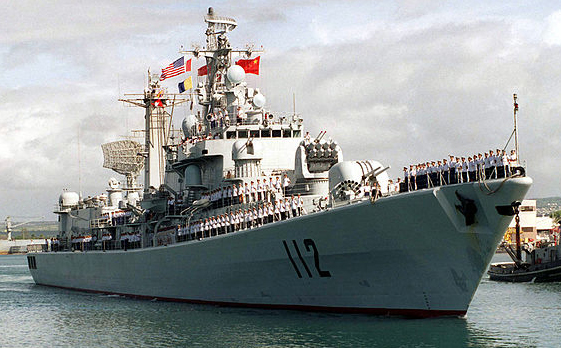
Harbin prior to the 2011 modifications
Those equipments also were never designed to operate together so integration was poor. There are clues that the next Luhai-class was specifically designed to address theses issues (but seems to have been not very successful either). At the same time the ships were considered still lacking modern electronic warfare and electronic counter-measures capabilities. However the 2011 refit was meant to deal with all these issues. In fact according to Chinese medias themselves and internet sources, the Luhu-class is indeed used as comparative technological demonstrators since both ships had different foreign systems.
Indeed Harbin was given a Raytheon AN/SQS-56 sonar, and Italian DE-1164 integrated sonar system and the Qindao was given a French Thomson-CSF DUBV 23/43 HMS/VDS sonar. Both were replaced by different Chinese sonar systems SJD-7 and SJD-9. The first also had the ZKJ-3 (ZKJ-III) based on the Italian designed IPN-10 combat data system SADOC-2 while the second had the ZKJ-4, based on the French Thomson-CSF TAVITAC. In 2011 they were replaced by the ZKJ-4A/B.
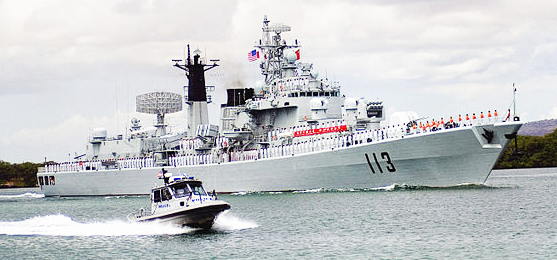
Qindao at Pearl Habor
The 2011 Upgrades
The Type 052 destroyers were upgradedin drydock, with many modifications, like the Type 76A dual-purpose guns replaced by two Type 730 CIWS on top of the helicopter hangar. The HHQ-7 SAM could have been replaced also by another system better suited against sea-skimming AShMs and on the electronic and active defence side, two Type 726-4 decoy launchers were installed on the forward bridge. Also system integration issues were solved for the most with the adoption of a new indigenous C3I system, the ZJK-4B and the Type 518 Hai Ying radar by the Type 517M long-range air search radarwhile the Type 362 air/surface radar was replaced by the Type 364 and SATCOM antennas added, plus the modifications described above. Thanks to these the ships went on a more active carrer. The Qindao was mated with the Type 054A frigate Yantai and supply ship Weishanhu to form the 11th Chinese naval escort flotilla operating in 2012 against Piracy in Aden and along the Somali coast. It was relieved by the Harbin, mated with the Type 053H3 frigate Mianyang and same supply ship (12th naval escort flotilla) in 2013-2014. In 2013 also Qingdao participated in the International Fleet Review 2013 in Sydney where she was abundently photographed. Both ships are regularly featured in the Chinese medias up to these days, but they are considered by all as transitional destroyers. Both are active with the North Sea Fleet.

Rendition profile of the Luhu class destroyers by the author
Read More/Sources
afcea.org – china copies russian ship technology use and profit
A Compendium of Armaments and Military Hardware (Routledge Revivals) By Christopher Chant
https://en.wikipedia.org/wiki/Type_052_destroyer


 Latest Facebook Entry -
Latest Facebook Entry -  X(Tweeter) Naval Encyclopedia's deck archive
X(Tweeter) Naval Encyclopedia's deck archive Instagram (@navalencyc)
Instagram (@navalencyc)





 French Navy
French Navy Royal Navy
Royal Navy Russian Navy
Russian Navy Armada Espanola
Armada Espanola Austrian Navy
Austrian Navy K.u.K. Kriegsmarine
K.u.K. Kriegsmarine Dansk Marine
Dansk Marine Nautiko Hellenon
Nautiko Hellenon Koninklije Marine 1870
Koninklije Marine 1870 Marinha do Brasil
Marinha do Brasil Osmanlı Donanması
Osmanlı Donanması Marina Do Peru
Marina Do Peru Marinha do Portugal
Marinha do Portugal Regia Marina 1870
Regia Marina 1870 Nihhon Kaigun 1870
Nihhon Kaigun 1870 Preußische Marine 1870
Preußische Marine 1870 Russkiy Flot 1870
Russkiy Flot 1870 Svenska marinen
Svenska marinen Søværnet
Søværnet Union Navy
Union Navy Confederate Navy
Confederate Navy Armada de Argentina
Armada de Argentina Imperial Chinese Navy
Imperial Chinese Navy Marinha do Portugal
Marinha do Portugal Mexico
Mexico Kaiserliche Marine
Kaiserliche Marine 1898 US Navy
1898 US Navy Sovietskiy Flot
Sovietskiy Flot Royal Canadian Navy
Royal Canadian Navy Royal Australian Navy
Royal Australian Navy RNZN Fleet
RNZN Fleet Chinese Navy 1937
Chinese Navy 1937 Kriegsmarine
Kriegsmarine Chilean Navy
Chilean Navy Danish Navy
Danish Navy Finnish Navy
Finnish Navy Hellenic Navy
Hellenic Navy Polish Navy
Polish Navy Romanian Navy
Romanian Navy Turkish Navy
Turkish Navy Royal Yugoslav Navy
Royal Yugoslav Navy Royal Thai Navy
Royal Thai Navy Minor Navies
Minor Navies Albania
Albania Austria
Austria Belgium
Belgium Columbia
Columbia Costa Rica
Costa Rica Cuba
Cuba Czechoslovakia
Czechoslovakia Dominican Republic
Dominican Republic Haiti
Haiti Hungary
Hungary Honduras
Honduras Estonia
Estonia Iceland
Iceland Eire
Eire Equador
Equador Iran
Iran Iraq
Iraq Latvia
Latvia Liberia
Liberia Lithuania
Lithuania Mandchukuo
Mandchukuo Morocco
Morocco Nicaragua
Nicaragua Persia
Persia San Salvador
San Salvador Sarawak
Sarawak Uruguay
Uruguay Venezuela
Venezuela Zanzibar
Zanzibar Warsaw Pact Navies
Warsaw Pact Navies Bulgaria
Bulgaria Hungary
Hungary

 Bundesmarine
Bundesmarine Dutch Navy
Dutch Navy Hellenic Navy
Hellenic Navy Marina Militare
Marina Militare Yugoslav Navy
Yugoslav Navy Chinese Navy
Chinese Navy Indian Navy
Indian Navy Indonesian Navy
Indonesian Navy JMSDF
JMSDF North Korean Navy
North Korean Navy Pakistani Navy
Pakistani Navy Philippines Navy
Philippines Navy ROKN
ROKN Rep. of Singapore Navy
Rep. of Singapore Navy Taiwanese Navy
Taiwanese Navy IDF Navy
IDF Navy Saudi Navy
Saudi Navy Royal New Zealand Navy
Royal New Zealand Navy Egyptian Navy
Egyptian Navy South African Navy
South African Navy






























 Ukrainian Navy
Ukrainian Navy dbodesign
dbodesign